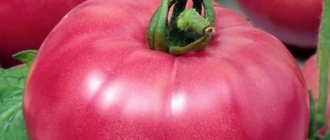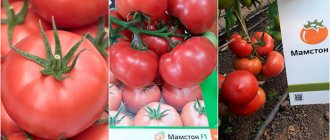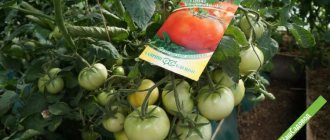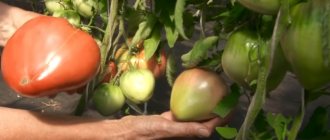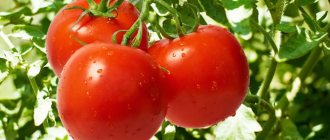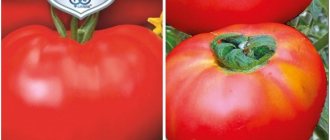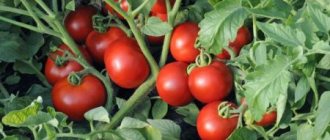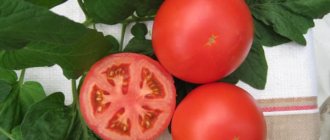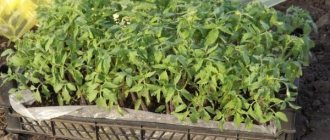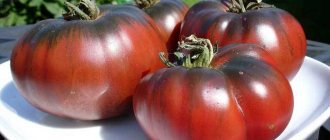Characteristics and description of Watermelon tomatoes
Watermelon was created by breeders of the Gavrish company specifically for growing in greenhouses. The variety is indeterminate, which means “without growth restrictions.” The top of the stem is pinched (artificially limiting the growth of the tomato) when the plant reaches a height of 180-200 cm.
The first fruit cluster is laid on the stem after the 8th true leaf, all the rest every 3-4 leaves. In total, up to 8 brushes can form on the plant.
Interesting! The structure of a tomato leaf is similar to that of a watermelon leaf, just as lacy and light.
The fruits ripen 110 days after sowing the seeds, which places Watermelon in the mid-early group of tomatoes. The weight of tomatoes is 120-160 g, the first fruits in a cluster can weigh 200 g. The shape of the fruit is flat-round, often uneven (in large specimens), with weak ribbing. The skin is thin, brownish-red in color with visible greenish stripes. Inside the fruit is multi-chambered and juicy. The pulp is tender, sweet, with a watermelon aftertaste.
The yield of Watermelon growing in a greenhouse is 4-5 kg per plant. In open ground, fruiting depends on weather conditions.
Productivity
One of the features of Watermelon tomatoes is that their fruits ripen gradually. On the bushes, tomatoes of this variety, judging by the reviews of summer residents, hold on quite tightly. Therefore, there is no need to rush to collect such tomatoes. Moreover, the longer the Watermelon fruits hang on the bushes, the sweeter they will become.
According to the description provided by the creators of this variety for Watermelon tomatoes, and also, according to many summer residents, these tomatoes, unfortunately, do not differ in keeping quality. Once picked from the bush, these tomatoes begin to burst and leak after a short period of time. However, such tomatoes usually hang completely intact on the plants themselves before harvesting. That is, on the bushes, judging by the reviews of summer residents, these tomatoes usually do not burst.
Pros and cons of the variety
Vegetable growers who are already familiar with the Watermelon tomato note its advantages:
- large fruit;
- early harvest formation;
- unpretentiousness;
- amazing taste of the fruit, high juice content in the pulp.
The main disadvantage is the thin skin of the Watermelon fruit and its juiciness. During the ripening period, tomatoes crack. They are not stored for long (no more than 2 days in a warm place and 5 days in the refrigerator), the juicy pulp quickly turns sour. It is better to immediately use the surplus harvest for processing - making juice, paste.
Reviews
On the Internet you can find a huge number of positive reviews about Watermelon tomatoes. Many amateurs who claim to have planted tomatoes for the first time note their rapid growth, ease of care and rich, long-lasting yield until autumn frosts.
Some non-professionals are upset by “deformed” fruits of incomprehensible shapes. It is difficult to say what this is connected with, but there is information that to avoid unsightly fruits, flowers should be picked when the bushes are flowering.
Gardeners themselves note that tomatoes grow and bear fruit well in greenhouse conditions. The main thing is to observe simple care conditions when growing them.
For the secrets of tomato productivity, watch the following video.
Having studied the reviews of gardeners who have already grown the Watermelon tomato variety on their plots, we decided to post some of them so that you can familiarize yourself with them and make a decision for yourself whether to grow this variety or not.
Svetlana Semenovna, Leningrad region
Marina Alexandrovna, Leningrad region
Anna Alekseevna, Kirov region
Ksenia Sergeevna, Ivanovo region
Elena Vyacheslavovna, Moscow region
Ekaterina Danilovna, Volgograd region
Irina Viktorovna, Moscow region
Galina Germanovna, Moscow region
Rules for growing tomatoes
Plants of the Watermelon variety can be grown not only in a greenhouse, but also in open ground. To do this, they are given a well-lit area with fertile soil. In the fall, before digging, a bucket of rotted manure or vermicompost is added to each square of the bed area. If the soil is clayey, add sand to loosen it.
To prevent tall bushes from being torn by the wind, the tomatoes are protected with curtains of corn. It will be successful to plant the crop along a fence or building on the south side.
Planting seedlings
Tomatoes similar to watermelon are sown 2 months before the expected date of planting in a permanent place. Depending on the climate of the region and the method of cultivation (in a greenhouse or outdoors), Watermelon is sown from February to April.
See also Popular varieties of ultra-early ripening tomatoes
Seeds purchased in the store have already been treated for diseases. They are germinated in a damp cloth for 2-3 days. If the seeds are old, Epin's solution can stimulate their development. Planting material collected from your tomatoes must be pickled in a pink solution of potassium permanganate or Fitosporin.
Tomatoes ready for sowing are immersed in the soil to a depth of 1 cm. Tall varieties are grown in separate pots, and as they grow, the seedlings are transferred to a large container. You can use peat tablets for sowing, after soaking them in warm water. Seedlings in tablets at the age of 1 month are planted in a regular 1 liter pot and covered with soil.
Seedling substrate for tomatoes is prepared from a mixture of forest soil, sand (vermiculite), and peat. Some gardeners buy peat substrate in the store and enrich it with humus. In addition to humus, mix 2 tbsp into 5 liters of soil. l. complex mineral fertilizer for tomatoes. Before applying fertilizer, the self-made mixture is steamed or roasted in the oven to get rid of mold.
Watermelon seedlings are kept on a bright windowsill, at a temperature of +20 +24 degrees, protected from drafts.
Tomato transplant
Tomato seedlings are planted in the ground when it warms up to +15 degrees. The plant does not tolerate temperature drops down to +2 degrees - it freezes. If frosts are expected after planting tomatoes in the garden, the bushes are wrapped in blankets and covered with sawdust and straw. If the tops of the tomato are frozen, new stems are formed from the side shoots.
The scheme for planting Watermelon in a greenhouse is 40 by 40 cm. In open ground, where a bush of 2 stems is often formed, the tomato is planted more spaciously, half a meter apart. It is recommended to deepen (plant the seedling “lying down”) the plant to the first leaves. New roots will soon form on the buried stem, and the nutrition of the tomato will improve. This will give a yield increase of 25%.
Preparing for landing
Before planting seedlings in the ground, it is worth hardening them off. The method of adjusting the temperature in the room where it is located received excellent reviews. During the day it should be raised to 19 degrees Celsius, and at night it should be lowered to no lower than 17 degrees Celsius. After this, you can move the seedlings to the greenhouse, planting them in a checkerboard pattern following a pattern of 40 X 60 centimeters.
This way you will provide enough space for the plants to grow, and during harvesting and when tying up bushes you will feel all the benefits of this arrangement. The seedlings that you plant in the ground must be carefully removed from the pots, leaving a little soil on the roots.
Features of care
After planting in the garden, the young “watermelons” are watered abundantly and the stems are immediately tied to the supports. In a greenhouse, a tomato bush is formed into 1 stem, mercilessly removing all the stepsons. All leaves up to the first flower cluster must also be removed. Outdoors, tomatoes are grown in 2-3 stems, pinching the top at a height of 1.5 m.
Water the Watermelon abundantly, allowing the plant to actively grow, 2-3 times a week. After filling the fruits, the amount of moisture is reduced to 1 time per week. Tap liquid is not used due to chemical additives. It must be kept for 2 days in an open container to release the chlorine.
To make work easier on tomato beds, you can install a drip irrigation system. Warm water, flowing through the sleeves directly into the tomato tree trunk area, effectively saturates the roots with moisture. Water savings with this irrigation system are 30%.
Expert opinion
Stanislav Pavlovich
A gardener with 17 years of experience and our expert See also How to plant and grow tomatoes on the balcony: the best varieties and step-by-step instructions
Ask a Question
Important! Drip irrigation helps avoid cracking of fruits during ripening, since moisture reaches the roots evenly.
Tall tomatoes need regular feeding. Watermelon is fed every 2 weeks, starting from the moment the seedlings are planted in the garden. Approximate scheme of plant feeding:
- infusion of chicken manure, 1 liter per bush;
- infusion of weeds + ash + iodine, 1.5 liters per bush;
- complex mineral fertilizer with microelements, spraying;
- infusion of bread or yeast, 1.5 l;
- complex fertilizer or a mixture of superphosphate and potassium sulfate, 20 g and 15 g per 10 l;
- infusion of ash, 1.5 liters per bush.
You can fertilize tomatoes at the root only in moist soil. Without pre-watering, the nutrient solution may burn the roots.
General information
The Watermelon variety is included in the State Register of Russia, which means that tomatoes are recommended for cultivation in our climate. However, residents of a number of regions with short summers plant these tomatoes only in greenhouse conditions. Gardeners in the Russian south and Central Russia can safely plant Watermelon tomatoes in open ground.
The variety belongs to the category of vegetables with an average ripening period and long fruiting. There are not many leaves, but the branches grow up to two meters. It is clear that the Watermelon variety needs staking and pinching.
Ask and receive useful advice from professional gardeners and experienced summer residents.>>
The lower leaves also need to be trimmed. This is done solely for the sake of unhindered air circulation at the base of the bushes. All foliage below the first cluster must be cut off from each branch. They do more harm than good. These leaves shade the lower fruits on the stems and the soil under the bushes. As a result, a favorable environment is created for the activation of the vital activity of fungal microorganisms, including root rot spores. However, with careful care, these tomatoes rarely get sick.
The fruit shape of this variety is elongated, slightly flattened. There are slightly noticeable “ribs” near the stem of the tomatoes, as in the photographs. At the top of a fully ripened fruit, a light brown spot is clearly visible. The bottom of each tomato remains dark green. Between these spots there are longitudinal stripes.
The yield of watermelon tomatoes is not that high, but at least 2.5 kg of very large, extremely tasty fruits are collected from each bush. In order for the tomatoes to be larger, you should not plant more than three bushes per square meter.
Harvest ripe tomatoes carefully as they are prone to cracking. Tomatoes of this variety look simply wonderful, but, unfortunately, are not suitable for long-term fresh storage and, as a result, for long-distance transportation
The skin on them is too weak for this
Tomatoes of this variety look simply wonderful, but, unfortunately, are not suitable for long-term fresh storage and, as a result, for long-distance transportation. The skin on them is too weak for this.
The taste of the Watermelon tomato is excellent. Salads and various dishes are prepared from them. They make delicious juice and seasonings, but due to their large size and weak skin, they cannot be pickled.
It is also important that Watermelon tomatoes ripen gradually; this process drags on throughout the summer. This means that you will always have fresh tomatoes at your table, so stock up on vegetable salad recipes
In addition, ripe fruits hang on the branches for a long time, although their flesh is tender.
The main drawback of the variety, judging by the reviews, is that the picked tomatoes need to be processed or eaten as quickly as possible, otherwise they will leak.
Growing
The Watermelon tomato is very heat-loving. In the south, the seeds, which, by the way, are produced, are planted directly in the garden bed, but for central Russia this option is unacceptable. Here, gardeners even cover the bushes with film and leave it for at least a week until the bushes begin to actively grow.
Seeds are planted for seedlings in mid-March, then the first fruits ripen by July. There is one peculiarity when sowing seeds of this variety. They should not be sown in a common container; it is better to immediately divide them into separate cups or peat tablets. The seedlings are turned daily so that they do not lean toward the light source. The soil should always be just slightly moist, but not soggy.
A month before transplanting seedlings, prepare the soil. Dig up the beds with the addition of humus. If the soil is heavy, add sand. After this, prepare the holes for the seedlings. They should be located at least 40 cm apart from each other. The gaps between the rows are about 60 cm. Immediately before planting the sprouts, add one spoon of sifted wood ash and dry mineral fertilizers to each hole. Pre-mix both components until smooth.
Rules of care
It is very important to know that during flowering and fruit set, this variety needs fertilizing with mineral fertilizers. The second important point is that it is recommended to regularly loosen the soil under these tomatoes, not to mention weeding
Water the watermelon tomatoes only at the root with warm, clean water.
Despite the incredible resistance to diseases, it doesn’t hurt to sometimes spray the Watermelon tomato with Bordeaux mixture or wormwood decoction for the sake of prevention.
Pest and disease control
Watermelon has genetic resistance to TMV, spotting, and leaf curl. But he may suffer from late blight. To protect tomatoes from fungal diseases, follow several rules:
- regularly ventilate the greenhouse;
- thin out the foliage in a timely manner so as not to thicken the bushes;
- spray tomatoes 2 times a month with copper oxychloride or whey solution.
If signs of the disease (brown or brown spots) appear on the leaves and fruits, the plantings are treated with Bordeaux mixture or Oxychom. These drugs can be used before flowering. Later you can use a pink solution of potassium permanganate, garlic infusion. Affected fruits and leaves are removed from the plant and burned.
Tender tomatoes are also threatened by insects: aphids, cutworms, spider mites, and whiteflies. It is effective to prevent pests from settling on the bush by spraying the plants with sharp-smelling decoctions and infusions. The smell of garlic, onion peels, tobacco, and wormwood will repel insects.
Use of fruits
Watermelon tomatoes are grown, as already mentioned, mainly for preparing summer salads. It is in such dishes that the fruits of this variety best reveal their taste. Also, many summer residents advise consuming fresh Watermelon tomatoes. The pulp of the fruits of such tomatoes is very juicy, pleasantly sour-sweet.
Unfortunately, the fruits of this variety are not very suitable for canning, according to many summer residents. Watermelon tomatoes are large in size. That’s why they usually simply don’t fit entirely into the jar. Sometimes quite small fruits grow on the bushes of this variety. Of course, if you wish, you can try such tomatoes and roll them into jars.
However, many summer residents still believe that these tomatoes taste best when fresh. In addition, the skin of this variety of tomatoes is quite thin. Therefore, when poured with boiling brine, Watermelon can simply burst. And eating such salted tomatoes will most likely not be very convenient.
